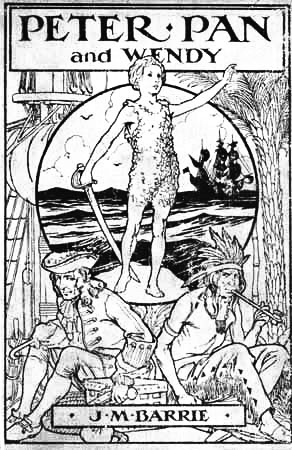
It seems safe to assume that most people are familiar with one version or another of the tale of Peter Pan. Some generations may be more familiar with the dramatic adaptations, including the famous debut of Mary Martin as Peter. Others may have enjoyed various picture book editions or young adult sequels and prequels. As a child I enjoyed the Disney animated version, and later the Spielberg sequel Hook. Like many, I didn’t read the original novel by Scottish writer J.M. Barry, Peter Pan and Wendy, until it was required in a college-level children’s literature course.
Throughout the class I was surprised to learn that the original Grimm’s fairy tales and other children’s folk stories were often a bit rougher around the edges than their sugary Disney counterparts. It was not uncommon to encounter gruesome violence, incest, and cannibalism in stories like “Red Riding Hood” and “Cinderella.” Though J.M. Barrie’s Peter Pan isn’t thematically horrifying, there are certainly elements that might trouble today’s parents.
First of all, the amount of violence in the book is rather startling. Compared to the Disney version, in which the pirates rarely receive more than a bop on the head, the novel is a bit more graphic, as Peter maliciously kills pirates without much concern or regret.
Modern readers may also be troubled by Barrie’s portrayal of women throughout the story. Wendy, Tiger Lily, and even fiery Tinkerbell are portrayed as damsels-in-distress, dependent on Peter to save them. In addition, the jealous interactions between these three female characters suggest that they view their own identities only through Peter’s eyes and feel unfulfilled without his attention. Furthermore, Wendy takes on the passive, stereotypical role of obedient housewife, as she doesn’t participate in any of the adventures of the Lost Boys and is merely content to keep house and dote on the rest of the children.
Readers may also be disturbed by the out-dated, inaccurate depictions of Neverland’s Natives who are referred to as “redskins” who engage in “savage” behavior. Throughout my reading, these elements of violence, racism, and sexism startled me, and I found myself grappling with an important question: Is it possible to look beyond these inappropriate components to appreciate the beautiful, imaginative tale beneath? Are we, in today’s society, too concerned with political correctness, or are we right to reject a children’s book for such reasons?
Of course, this is a question everyone must answer for themselves. I believe it is possible to enjoy a novel despite its disparity in societal values and standards. This cannot be accomplished by simply ignoring the book’s troublesome passages. As readers, we can seek to recognize and question these sections while allowing ourselves to enjoy the whimsical, innocent episodes, like the hunt and capture of Peter’s mischievous shadow. After all, Peter Pan helped to establish many fundamental tropes of the children’s fantasy genre, like the existence of an alternate world and the presence of fairies and other remarkable creatures. Despite the story’s flaws, I found the image of Peter perched outside the nursery window, looking inside at a scene from an ever-recognizable childhood, stayed with me long after the story’s conclusion. I predict that J.M. Barrie’s novel, flaws intact, will occupy our society’s collective imagination for years to come.
To learn more about J.M. Barrie’s work and his inspiration for the chilling villain Captain Hook, check out this LT article by Rachel McGinnis.
